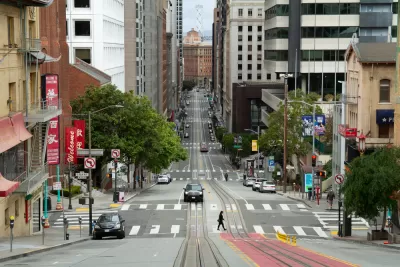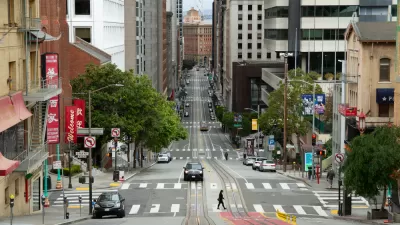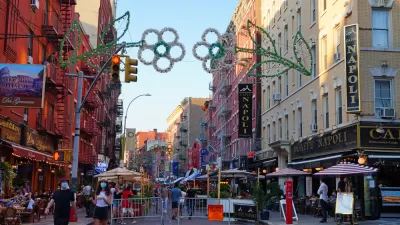“Downtown on the Brink” reads the headline of a recent San Francisco Chronicle feature.

Some Downtown San Francisco storefronts are still shuttered and graffitied, but some signs of life are returning to the streets as professionals and tourists return to the city’s famous urban neighborhoods. But the city’s Downtown is far from back to normal, and big changes will be necessary to avoid a “general economic decline,” according to a big interactive feature published recently by the San Francisco Chronicle, written by Noah Arroyo with visual supplements by Jessica Christian.
“Before the pandemic, office work was responsible for a whopping 72% of the city’s gross domestic product, according to the Controller’s Office — work that was heavily concentrated in the Financial District, the Market Street corridor, the Embarcadero and Mission Bay,” writes Arroyo.
Various metrics indicate Downtown San Francisco is far from recovered from the effects of working from home and social distancing. Office Space vacancy is up from 4.8 million square feet in the first quarter of 2019 to 18.7 million square feet in the first quarter of 2022, according to data presented in the article. That’s the highest level of office vacancies since the Great Recession. Convention attendees have dropped from 221,500 to 30,300 in the same period, and BART exits are down from 9.8 million to 2.3 million. Sales tax revenue in 2021 dropped to 33.5 million, compared to 55.6 million in 2019.
More data is included in the source article, with discussion of these trends focused on the effect for the city’s coffers, local businesses that operate in downtown neighborhoods, and public safety. The article also, however, asks “city planners, businesses and residents” what they will do in response.
“City officials and business leaders are working together, understanding that unless the city can defy national remote-work trends, its economic core will be forever altered,” writes Arroyo. So far, the San Francisco Office of Economic and Workforce Development is working on a strategy to bring the city’s economic core “back to life,” according to the article, but so far, city officials are taking a wait-and-see approach.
“It’s a bit premature for us to share specifics at this stage,” said Gloria Chan, the office’s director of communications, in an email to the Chronicle.
FULL STORY: Downtown S.F. on the brink: It’s worse than it looks

Planetizen Federal Action Tracker
A weekly monitor of how Trump’s orders and actions are impacting planners and planning in America.

Restaurant Patios Were a Pandemic Win — Why Were They so Hard to Keep?
Social distancing requirements and changes in travel patterns prompted cities to pilot new uses for street and sidewalk space. Then it got complicated.

Map: Where Senate Republicans Want to Sell Your Public Lands
For public land advocates, the Senate Republicans’ proposal to sell millions of acres of public land in the West is “the biggest fight of their careers.”

Maui's Vacation Rental Debate Turns Ugly
Verbal attacks, misinformation campaigns and fistfights plague a high-stakes debate to convert thousands of vacation rentals into long-term housing.

San Francisco Suspends Traffic Calming Amidst Record Deaths
Citing “a challenging fiscal landscape,” the city will cease the program on the heels of 42 traffic deaths, including 24 pedestrians.

California Homeless Arrests, Citations Spike After Ruling
An investigation reveals that anti-homeless actions increased up to 500% after Grants Pass v. Johnson — even in cities claiming no policy change.
Urban Design for Planners 1: Software Tools
This six-course series explores essential urban design concepts using open source software and equips planners with the tools they need to participate fully in the urban design process.
Planning for Universal Design
Learn the tools for implementing Universal Design in planning regulations.
Heyer Gruel & Associates PA
JM Goldson LLC
Custer County Colorado
City of Camden Redevelopment Agency
City of Astoria
Transportation Research & Education Center (TREC) at Portland State University
Camden Redevelopment Agency
City of Claremont
Municipality of Princeton (NJ)




























